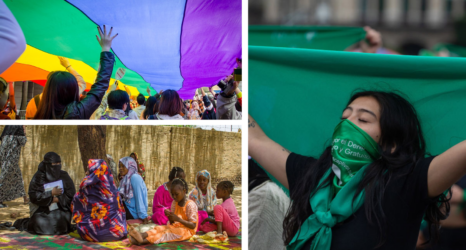Indian lawmakers recently announced mandatory installation of panic buttons and other emergency devices in buses throughout the country in an effort to combat sexual violence in the region. In addition, India’s Communication Ministry issued a mandate which would require all mobile phones made manufactured and sold to include a similar panic button device, with implementation to begin in 2017. But not everyone sees these new steps as harbingers of change.
In 2014, the National Crime Records Bureau reported 337,922 instances of male violence against women in India. This figure includes over 36,000 rapes, a rise of 9% from the numbers for 2013. It is likely that the real incidence of rape is significantly higher than official figures suggest, both due to under-reporting and lack of investigation. Public transport has been an area of particular concern. A recent ActionAid UK report found that four of five women (79%) in India experienced some form of harassment or violence in public and over a third (39%) said they had been groped or touched in public.
This issue was thrust into the global spotlight after the horrific 2012 Delhi gang rape, when a group of men brutally attacked and raped physiotherapy student Jyota Singh, who passed away following the attack. In December 2015, we reported India was beginning to take steps to ensure the improved safety of its public transit passengers, and last month this panic button announcement was one of the first steps toward material change.
This policy change extends to new and old buses alike. Newer transport vehicles are built with monitoring devices such as close-circuit cameras and vehicle tracking systems already installed, while older model buses would be retroactively equipped with this technology. The Indian state of Rajasthan started trials of the new law on 20 of its vehicles. With this new system, panic buttons are placed above the front doors of buses and, if pressed, send emergency signals to police control rooms, where officers would then be able to track live footage of the vehicle’s interior.
A spokesperson for the Internet and Mobile Association of India (IAMAI) has said that use of an app or police control facility could still fail if the response is not prompt and tailored to the circumstances. In their statement, the IAMAI stated the government should strive to enforce existing legal initiatives and “sensitize the agencies to handle emergency situations rather than mandate conditions that are deemed to fail from its inception.”
In its statement, IAMAI referenced a prior attempt at app-based safety measures, when in 2015 Delhi Police launched a mobile panic button app for Safety of Women called Himmat. According to the association, this app failed to work effectively, and instead of taking time to improve its flaws, law enforcement designed another app less than six months after Himmat‘s debut. IAMAI is calling for improvements to the new app’s back-support system as well as the creation of a national emergency response number.
Response time isn’t the only area in need of improvement. Because 68% of India is rural, phone service is not as universally accessible. Of India’s nearly 1.3 billion population, only about 17% possess smartphones, leaving a majority of the country’s female population unable to reap the benefits of a panic button app. While the new measures are good in theory, results will depend on their implementation.
Sehjo Singh, of the anti-poverty group ActionAid India, emphasized the need for consistent follow-up action, not just new technology. “What the government needs to do is restore the faith of the people,” Singh said. “So far, our experience is that new mechanisms and institutions are created, but there is no follow-up.”
Not only this, but rape prevention efforts which depend primarily on women’s capacity to report rape and sexual assault fail to take aim at the roots of male violence and sexual aggression. “India is a country with patriarchal social values and thinking,”Annie Raja, general secretary of the National Federation of Indian Women, said in a statement to Al Jazeera. She continued that because the women in India aren’t seen as equal citizens, no amount of newly created laws will end violence against women in the region. What’s required now is a focus on cultural change that results in a society where sexual violence is deemed unacceptable.
The ultimate goal will always be to build a culture where women don’t need panic buttons. In India, and elsewhere, that means doing a lot more work.





